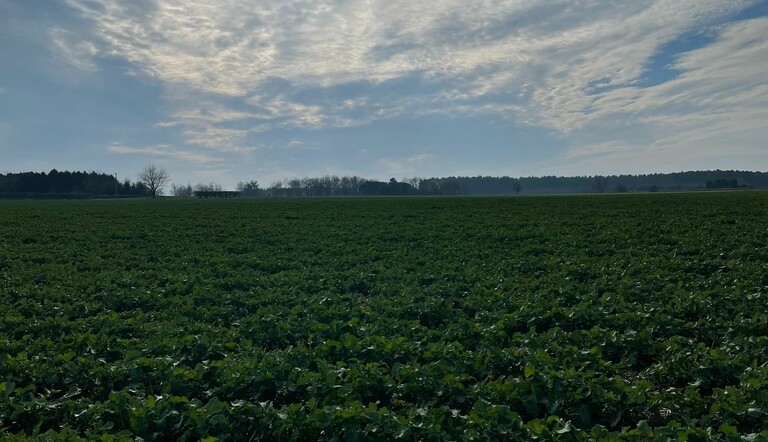
Powering-up Post-Emergence Weed Control in Oilseed Rape

For post-emergence herbicide treatments, a selection of different active ingredients and modes of action should be used as this will maximise weed control and can also help to reduce the risk of weeds becoming resistant to any individual active ingredient.

Several grass and broad-leaved weeds are already resistant to a number of herbicides, so it pays to use a range of actives throughout the season to spread the risk and reduce the over-exposure of any single active.
ADAMA early post-emergence herbicide applications to OSR and effect on companion crops
Many growers are turning to companion cropping as an option to reduce the host finding effectiveness of cabbage stem flea beetle (CSFB). The principle proven species for CSFB confusion strategies is buckwheat and all the herbicides in this article will have no or minimal effect on buckwheat
POST-EMERGENCE HERBICIDE OPTIONS
ADAMA’s range of post-emergence herbicides are not only proven to boost OSR yields and crop viability but have also been shown to have little or no effect on the most commonly used companion cropping species, buckwheat, which more and more growers are turning to in an effort to reduce the influx of cabbage stem flea beetle.
SULTAN® 50 SC (500 g/l metazachlor) is a cost-effective residual herbicide for use in winter and spring oilseed rape to control a wide range of broadleaved weeds and annual grasses including annual meadow grass and black-grass and versus other problem weeds including common chickweed, bur chervil and mayweed species.
SULTAN® can be used at pre- or early post-emergence (up to four leaves of the crop): this gives growers the option to delay spraying until GS12-14 if the pre-emergence window was hampered by poor conditions or if the seedbed was poor and cloddy.
SULTAN® is approved for use on all soil types except the very lightest land, sands and those with more than 10% organic matter.
SULTAN® also provides incidental control of Bur Chervil: a weed which is rapidly becoming increasingly troublesome for many growers.
Irrespective of whether SULTAN® is used as a pre- or post-emergence treatment, it must be used in accordance with the guidelines set out within the Voluntary Initiative
Stewardship Scheme to prevent run-off and leaching losses into water courses.
PLEASE NOTE: do not use SULTAN with filters finer than 50 mesh.
FALCON® (100 g/l propaquizafop) is incredibly good at controlling volunteer cereals in a wide range of crops and is also useful against annual meadow grass up to three leaves. Reduced rates are typically used for volunteer cereals with the dose dependent on the crop species, with accurate timing of application critical to efficacy.
FOX® (480 g/l bifenox) bifenox is recommended for the post-emergence control of a wide range of broad-leaved weeds in winter oilseed rape, delivering good control of field pansy, black-bindweed, charlock, red dead nettle and speedwell species..
LEGION® (375 g/l metazachlor and 125 g/l quinmerac in an SC formulation) is a residual herbicide for use in winter oilseed rape. LEGION® can be used as a pre- or early post-emergence treatment (up to the 4-leaf stage and before the end of January) to control annual meadow-grass and a range of broadleaved weeds. LEGION® provides improved cleaver and poppy control compared to SULTAN® 50 SC and is very effective against Bur Chervil: in Germany, where ALS herbicide resistant Bur Chervil is a problem, LEGION® typically delivers more than 90% control when used as either a pre- or post-emergence treatment.
CROP COMPETITION AS AN INTEGRATED PART OF WEED MANAGEMENT
In addition to pre- and post-emergence herbicide applications, OSR growers should also focus on maximising the crop’s competitiveness as a means of managing weeds: in fields with a high weed burden, or where volunteer cereals are a known issue, maximising the crop’s competitiveness can be as important as the herbicide strategy itself, not just in the crop’s early growth phases, but throughout the growing season when other stresses such as drought, waterlogging or winged pests might become a factor.
The starting point for any such strategy is to ensure the crop establishes well so that it can grow away quickly. This can be encouraged through the following agronomic practices:
Optimise seed rates:
Sowing at an appropriate seed rate will ensure the OSR crop forms a suitably dense canopy quickly to suppress weed growth by limiting the light and space available to weeds.
Timely drilling:
Ensuring OSR is drilled in conditions that favour rapid germination, and early growth will give the crop a head start over weeds. This is particularly important when using pre-emergence herbicides as it enables the crop to take advantage of the reduced weed competition.
Nutrient management:
Providing adequate nutrients during the early stages of the crop’s growth supports vigorous OSR establishment, further enhancing its competitive edge.
Latest articles

A look at the next generation of cereal disease control - ADAMA In Action 2025
